How Can You Relieve Joint Pain in the Big Toe?
October 3, 2025

Pain in the big toe is very common and affects millions of people each year. There are many different causes of pain in the big toe, ranging from a fracture of the bone to many forms of arthritis. And if you’re here, you’re most likely wondering, “How can you relieve joint pain in the big toe?”And for good reason. The big toe can be very painful when injured, and the pain is hard to miss when you stand, walk, or run. Your largest toe provides an important assist when pushing off and takes almost twice as much weight as the other four toes combined. It’s also essential for balance and strength.
Can a Massage Therapist Help Joint Pain in the Big Toe?
Massage therapists like to think we can help any kind of pain, and in my 60-year career, I have certainly helped a lot. But it’s important to know what you can’t help, too. And with joint pain in the big toe, there is little that a massage therapist can do to treat the source of the pain. So when someone comes to me with this kind of pain, I refer them to the right treatment to get help.
Before we get into treatment, though, let me go over a little anatomy.
How Do Joints Work in the Human Body?
A joint is formed where any two bones meet. The ends of the bones are covered with a smooth Teflon-like material, called articular cartilage. And inside the joint itself is a special fluid, called synovial fluid. Both articular cartilage and synovial fluid help the joint work seamlessly, so your bones can easily and smoothly glide over each other.

You have two joints in the big toe that can be extremely painful when injured. They have pretty complicated names, so I’m going to refer to them as Joint 1 and Joint 2. Joint 1 is near the tip of the toe, and Joint 2 is at the ball of your foot.
What are Common Reasons for Big Toe Joint Injuries?
Joint 1
The most common cause of injury to Joint 1 is when we stub a toe. As the toe bangs into an object, it jams, traumatizes the joint, and causes inflammation. Extra fluid is produced in the joint, which causes swelling and makes it painful to bend the joint and, therefore, walk.
Joint 2
This joint is where the pain is the most common.

The toes are meant to be straight and were that way when you were born. Look how the big toe is totally aligned and straight on a baby’s foot. When Joint 2 is straight, your weight is evenly distributed, but when it is out of alignment, tremendous weight and stress is put on one side of the foot.
Wearing tight shoes around the toes often forces the big toe to move out of alignment, which puts extra stress on this joint. Over time, this stress causes damage to the joint and results in painful inflammation.
What Does Good and Bad Toe Alignment Look Like?
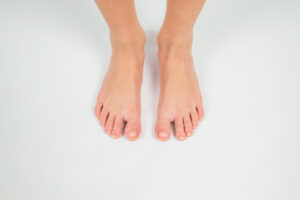
In this photo, the adult toes are in alignment. Notice that the big toe doesn’t bend toward the other toes. The feet are parallel, and the toes are straight.
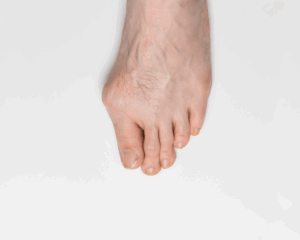
In this photo, the big toe has moved way out of alignment, and Joint 2 is enlarged. This misalignment makes the person vulnerable to injuries to both Joint 1 and Joint 2, as well as the formation of a bunion. This misalignment is very common and can cause multiple foot problems.
How Do You Figure Out Which Big Toe Joint is Injured?
Sometimes, it’s obvious which joint is injured because there is no “referred pain” in the toes. Referred pain happens when an injury is in one place, but it hurts in another place, often five or six inches away. When a joint is injured, it swells, which often means the sense of where the pain is can be confusing.
Fortunately, figuring it out in the big toe is easy. All toe joints are hinge joints, which means they only bend in two directions, just like a hinge. Flexing curls the toe, and extending straightens and lifts the toe. You should be able to make both joints flex and extend with no pain. If it hurts in either or both directions, it means the joint is inflamed.
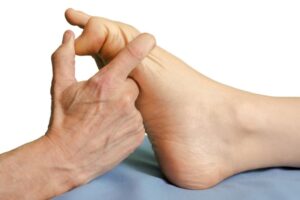

First, bend the first section of the toe down toward the heel and see if that causes any discomfort. Make sure you’re only moving Joint 1, the one closest to the tip of your toe. Then, move your toe in the opposite direction and see if that causes any pain. If it does, it means that Joint 1 is inflamed.
As previously mentioned, the more common injury is in the Joint 2, but this test is also very easy.

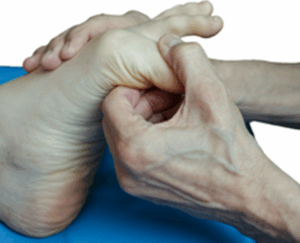
First, bring your toe back toward your ankle as far as you can. If it hurts, it’s inflamed. Then, bend your toe in the opposite direction as far as you can. It can usually go farther than you think. And if either or both directions cause any discomfort, you know the joint is inflamed.
What Is Joint Inflammation, and Why Does It Hurt?
The word arthritis literally means “joint inflammation,” so when your joints are inflamed, you have arthritis. But not the kind you typically think of! There are over 100 different forms of arthritis, and the type I am describing here happens because of an injury. Like you bang your toe, or because your toe is so misaligned that the joint becomes irritated. Additionally, arthritis is painful because a swollen joint has excess fluid inside it, which blocks your full range of movement.
How Do You Treat Big Toe Joint Inflammation?
There are only two treatment options when a joint is inflamed. If you do nothing, the joint continues to deteriorate and remain painful.
Rest and Stretching
If the inflammation is relatively mild and has happened recently, you can try rest and mild daily stretching. Rest means doing nothing that causes pain. If running hurts, choose something that doesn’t stress your toe, like biking or swimming.
To stretch the joint, do the tests mentioned earlier, but do them very gently. Never hold the stretch. You want to flex and extend your toe as far as you can without pain. This should not hurt.
Injection Therapy
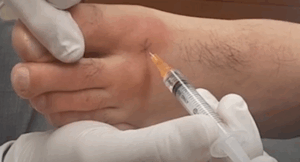
If the pain is more intense or if it has been with you for a long time, the best treatment is injection therapy. There are two types of injections, usually given a week or so apart. First, a doctor would use a cortisone injection to reduce inflammation in the joint. Then, a week later, they would strengthen the joint with reconstructive proliferative therapy.
What Is Reconstructive Proliferant Therapy, and How Does It Work?
You have likely never heard of reconstructive proliferant injection therapy. Reconstructive proliferant therapy (also called prolotherapy) is a technique that stimulates the body’s ability to repair itself when that process does not occur naturally. Just as a cut or scratch initiates the skin’s regenerative processes, a proliferant causes the production of new tissue by stimulating cell reproduction. Until proliferants were discovered, it was believed impossible for joints, ligaments, and tendons to regenerate this way.
The proliferant is injected into the affected area and causes local inflammation. This controlled inflammation triggers an accelerated healing process, resulting in the production of new cells. The proliferant enhances the health of the joint and counteracts any side effects of the cortisone.
You may have heard of PRP, which stands for Platelet-Rich Plasma. It is a similar treatment to proliferant therapy, but it uses a patient’s own blood cells to promote healing and stimulate growth. It’s much more expensive than prolotherapy, but it may be more common or available where you live.
An Important Disclaimer About Reconstructive Proliferant Therapy
To be up front, sometimes the injection therapy works, and sometimes, it doesn’t. I choose to still refer people to this treatment because there is a good chance it will work and because I have seen great success stories over the years. I had one client who had pain for 5 years: they went for this injection therapy, and then never had pain again. Only you can make the choice that’s most comfortable for yourself and your body.
You Don’t Have to Live in Pain with a Joint Injury in Your Big Toe
Time will usually allow your big toe joint to heal if you just stubbed your toe. But if your toe is out of alignment and inflamed because it is constantly stressed, you need treatment and work to realign it. Your local podiatrist can usually help you, as well as a skilled trainer or dance teacher who specializes in alignment.
If you are experiencing pain in your big toe and live in the Boston area, schedule an appointment or a complimentary 10-15 minute phone consultation.
Schedule an Appointment or Call →
Ben E. Benjamin holds a Ph.D. in Sports Medicine and was the founder and President of the Muscular Therapy Institute in Cambridge, Massachusetts. He is the author of dozens of articles on working with injuries and chronic pain as well as the widely used books in the field, Are You Tense? Exercise Without Injury and Listen To Your Pain: The Active Person’s Guide to Understanding, Identifying and Treating Pain and Injury. Dr. Benjamin has been in private practice for over 50 years and teaches therapists throughout the country.
How Can You Relieve Joint Pain in the Big Toe? FAQs
- Can a massage therapist help joint pain in the big toe?
There is little that a massage therapist can do to treat the source of the pain. They should refer their clients to the right treatment.
- How do joints work in the human body?
At the place where two bones meet, is a joint. The joint bones have articular cartilage at their ends, and inside the joint is synovial fluid. Both work together so that your bones can glide over each other.
- What joints in the big toe are typically injured?
The first joint near the tip of your toe and the second joint in the middle of your toe.
- What are common reasons for big toe joint injuries?
Stubbing a toe or wearing such tight shoes that your toe becomes misaligned.
- What does good and bad toe alignment look like?
Good toe alignment is when your toes are straight and parallel to each other. Bad toe alignment is when the toes are pointed in, toward the other toes.
- How do you figure out which big toe joint is injured?
You can perform a couple of easy tests on your joints, where you extend and flex your toes to see where the pain is.
- What is joint inflammation, and why does it hurt?
When a joint becomes inflamed, it becomes swollen with excess fluid, and that fluid creates pain when you try to move your toe.
- How do you treat big toe joint inflammation?
If your injury is mild, you can rest and stretch your toes. If your injury is more severe or has lasted a long time, I recommend injection therapy.
- What is reconstructive proliferant therapy, and how does it work?
It stimulates cell reproduction and simulates the body’s ability to repair itself. The needle goes into the joint to inject this proliferant.
- What should I know about reconstructive proliferant therapy?
Sometimes it works, and sometimes it doesn’t. However, I have seen great success stories over the years. Make the choice that’s right for you.
Related Posts

Why Does My Old Injury Still Hurt?
Question: What is the common denominator of chronic pain?
Answer: ADHESIVE SCAR TISSUE

Can Massage Help Pain that Travels? Cambridge MA
Question: Why does an injury to the neck cause pain that travels to the arm and hand? Answer: Referred Pain Pain that travels in your body is called Referred Pain. This phenomenon means the injury is in one place, and the pain is in another. Understanding this phenomenon helps you better understand your body’s responses […]

Can Massage Therapy Help Lower Back Pain Cambridge, MA?
Lower back pain is experienced by at least 50 million people each year in the United States alone. My own severe back pain when I was a teenager is what led me into this field. Back pain is often a debilitating, terrible experience. But it can also be annoying and limiting. I’ve treated hundreds of […]

Massage Therapy for Chronic Neck Pain Near Cambridge, MA
Question: What’s the most common cause of chronic neck pain? Answer: Ligament sprains The Causes of Pain in Your Neck For many reasons, your neck can be painful, but most people are unaware of the most common cause of chronic neck pain. Sprained or severely injured muscles can cause pain in the neck, but muscles […]

Can a Massage Therapist Fix a Frozen Shoulder in Cambridge, MA
Question: Does a frozen shoulder always go away with time? Answer: Often no. The Causes of Frozen Shoulder A frozen shoulder can be incredibly painful. The pain originates in the shoulder joint. A joint is formed where any two bones meet. It’s the enclosed space between your upper arm bone, the humerus, which is […]
